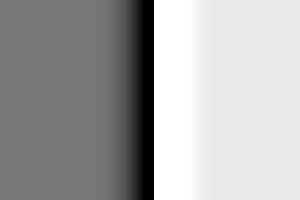
Do you want to know if it’s a good idea to do Stand development in D76? And what dilution to use for that? Then here is the short answer. In one line : DON’T DO IT! Based on my personal experience, various experiments and logic based on photochemistry-
I used 1:4 D76 in my 1500 ml tank that takes 6 negatives of 4×5 size as a first try. The commonly followed stand development procedure is 1 minute initial agitation followed by 1 hour (or time of your choice) stand with no agitation (True Stand development). I knew, even before I started, that being a solvent developer, D76 is not a good candidate for stand development. Actually, there are two reasons why it’s not a good choice but we will get to that.
First the stand development results :
I got horribly mottled 4×5 negatives. The worst I’ve ever seen, or developed. Even my very first 35mm negatives looked better. Not just that , there was a foggy, muddled, unsharp look to them that I’ve never seen on a negative, almost like the emulsion went completely liquid and moved around. Imagine the most extreme uneven development possible, and then do it twice. Also, the spotting /mottling on the negatives was not like the kind you get from expired negatives, or some of the cheaper old-style emulsions like Efke, or negatives that have been exposed to excessive heat or other extreme weather conditions. That produces small dots with sharp, well defined edges. The stand development in D76 produced large spots (~ 1mm) with a circular gradient type form. Completely unusable negatives. I bet even Sally Mann or Joel Peter Witkin can’t use these imperfections to an artistic advantage.
Later, I tried more dilution (1:6 and 1:10) but the negatives are too thin to be usable, and the spots are still there, though in lesser quantity. As you may know, D76 is a reasonably mild developer. Also, the uneven development becomes more severe as you dilute further. Why I tried this is beyond me, since all my scientific training was telling me that nothing good could have come out of this.
So What’s the problem with D76 and stand development?
To understand that, we first have to look at how stand development works – why we can leave film in the developer for so long and still hope to get a non-dense negative, and why we care to do stand development at all.
The Stand development Mechanism:
As you may (or may not) know, there are TWO main effects that make stand development special : Adjacency Effects (also called edge effects) and Compensating Effects. In English: Increased edge definition (edge contrast – sharpening of edges, whatever you want to call it) without excessive increase in overall contrast.
Both these effects are caused by the same key factor : Localized developer exhaustion.
Essentially, the active reagent in the developer gets used up and development stops. This happens in different parts of the negatives at different points of time during the “standing time”. Luckily for us, this is exactly what we need for both keeping the overall contrast under control and increasing the contrast around edges (which makes them appear sharper – this is the exact same principle behind the Unsharp Mask concept, both in darkroom as well as in lightroom / photoshop). How is that, you ask? Let’s see the overall contrast control in stand development first, since it’s easier to understand (and less to explain as well).
Compensating effects of stand development
Here is what happens. The film is sitting in the developer but there is a limited amount of developing agent available. The highlight areas in the negative, which received a lot of light during the development, are full of very agitated silver halide particles (ignore the chemical names, if that scares you). They are like hungry dogs, tortured by the sun into extreme excitement. So when the developing agent (food), is served, they start gobbling it down at a rapid rate. This is true in any kind of development not just stand development. Excessive contrast is like over fattening of these molecules (sorry dogs), which we don’t want. The good thing about stand development is that there is only limited food available. So after a little while, the highlight areas are out of developing agent, and they can’t develop(!) any more. Both the high dilution of the developer as well as the the lack of developer motion contribute in this exhaustion of the developing agent. On the other hand, the shadow areas, which did not receive a lot of light, are are in a very mildly excited state, so they eat up the developing agent quite slowly, and keep on developing till much longer, without running out of food. The effect is Increased development of shadows, and attenuated development of highlights. So the film curve is compressed from both sides (sorry, can’t resist talking about curves), i.e. contrast is reduced from both ends. (The overall contrast is basically the difference between the lightest and darkest areas). Now can you think why D76 would fail in a situation like this? Think! (Hint: Hydroquinone)… No? Ok answers are coming.
So what about the “other thing” – increased apparent sharpness?
Stand Development: The Adjacency Effect
Now imagine you are at a an edge in the negative, say a dark tree branch against a light sky, or a Caucasian hand against a black suit. On the highlight side (sky) again, there are too many excited denizens who start gobbling up the developing agent, becoming very fat and running out of it soon. On the shadow side (branch), the dudes are taking it easy, not too excited about the developing thing (after all they were in darkness), so there is still developing agent. Now if you’ve heard of diffusion, (or have common sense) what happens is the extra developing agent from the darker side, seeps just a little bit to the highlight side. The hungry particles on the highlight side gobble even this extra bit of developer up, becoming even more fat. At the same time, the concentration of developing agent on the shadow side of of the edge goes down, reducing development further.
So we get a small band near the edge where the dark side becomes even darker and the light side becomes even lighter. i.e. Increased local contrast which naturally leads to Apparent increase in edge sharpness. Brilliant, isn’t it? (In fact, these images were generated using unsharp mask in your favorite editing software).
So, coming back to the good old Question:
Why does D76 stand development not work, at all?
For two reasons. Here is the main one. The big one… Coming up. Can you guess ? Can you? Can you? It is really quite simple.
It doesn’t get exhausted!
The Metol-Hydroquinone combination in D76 is quite efficient. (Metol and Hydroquinone are the two developing agents in D76). It’s one of the two most efficient super-additive developing agent pairs known to mankind. (The other is phenidone-hydroquinone). Here is the cool part: The bi-products produced by hydroquinone while developing regenerate the metol from its development bi-products. So, even at lower dilutions, if there is enough developing agent to give you a reasonable negative, then it is going to be there through out, in highlight as well as shadow areas. That explains the lack of compensating effects in D76 stand development. Stand or agitate, no compensation for you.
Now the second thing : The Sodium Sulfite!
As I mentioned earlier, D76 is a solvent developer. What that means is that during development, the silver grains (crystals) that are being formed are dissolved by the sodium sulfite in the solution to some extent, to give them a more rounded less edgy feel. There is also some silver replating that is happening to further reduce the apparent grainyness, but let’s not get into that. The point to be taken away is that D76 has a natural tendency to smear or smug the grains. (This is characteristic of all solvent developers). So even if some edge effects might be taking place, the sodium sulfite goes there and smears the edges a bit undermining the adjacency effects.
You might think that all this would be solved by just diluting D76 further, say 1:15 or 1:20. The problem there is that D76 is a relatively mild developer. Diluting it too much will just give you a transparent negative. Even though dilution reduces the sodium sulfite concentration quite a bit, reducing its effects, it also pushes D76 below the minimum concentration required for it to be active at all.
So, what to do? Here are some
recommendations for Stand development.
In decreasing order of effectiveness:
- Use a “non-solvent” developer.
- Use a developer with a SINGLE developing agent.
- Preferably a developer with very little or no Sodium Sulfite.
- The developing agent should be quite strong to be effective at high dilutions.
But what if you don’t have access to any other developer, and are stuck with D76, AND you still want edge effects and compensating effects? (After all, that’s what we are after, not some mythical virtues attached to stand development). There is a compromise. It’s called the
Minimal agitation development with D76
The recommended procedure for development with for minimal agitation is
1 minute initial agitation, followed by
3 inversions every 3 minutes.
In order to reach your usual overall contrast, you will have to increase the development time. 50% increase is a good starting point for calibration.
Got a story to share about developing with D76? Or stand development Fiascos with other developers? Share with us.

